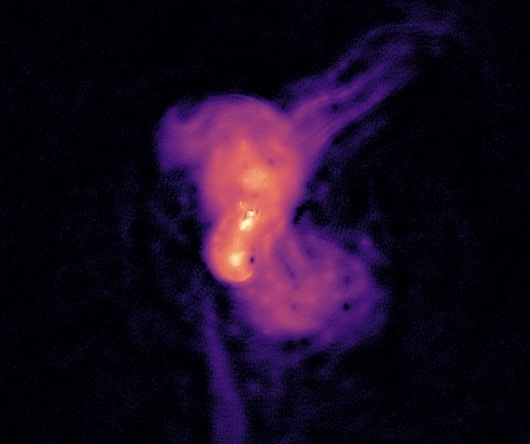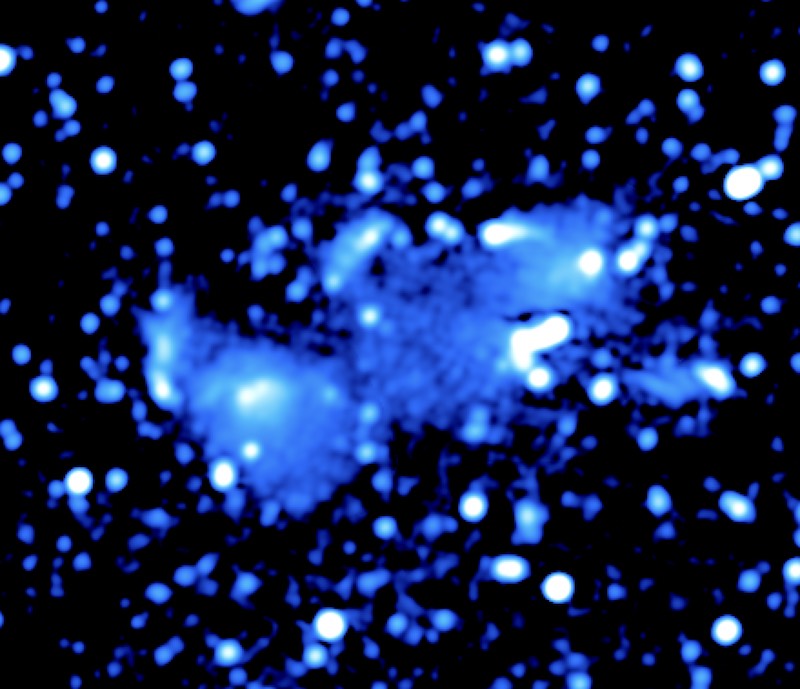ClusterWeb
The
ERC-StG ClusterWeb project aims to unravel the
origin of cosmic rays and magnetic fields in galaxy
clusters and the lower-density regions beyond them. It
also seeks to understand how supermassive black holes
in galaxy clusters interact with their environment. To
tackle these questions, ClusterWeb researchers use
cutting-edge radio telescopes with significantly
improved sensitivity, survey speed, and angular
resolution. Recent advances in correcting for Earth's
ionospheric distortions further enhances the
capabilities of these telescopes.
LOFAR,
a pan-European radio telescope, plays a central role
in the project. As an IT-telescope employing
phased-array technology, LOFAR combines signals from
numerous low-cost antennas in a supercomputer to
emulate a giant telescope. Its sensitivity and angular
resolution are more than an order of magnitude better
than any other low-frequency radio telescope. The
LOFAR observations are complemented by data from the Chandra,
XMM-Newton,
and Planck
satellites, providing a comprehensive multi-wavelength
view of these cosmic structures.
ClusterWeb is organized along three scientific
themes further detailed below.
MERGING GALAXY CLUSTERS AND PARTICLE ACCELERATION
 Radio observations of galaxy clusters have revealed
the presence of large, megaparsec-scale diffuse
synchrotron-emitting sources known as radio halos and
relics, depending on whether they are located near the
cluster center or in the outskirts. The detection of
synchrotron radiation indicates the presence of cosmic
rays and magnetic fields within the intracluster
medium (ICM). With their vast extent, these sources
trace some of the largest particle accelerators in the
Universe.
Radio observations of galaxy clusters have revealed
the presence of large, megaparsec-scale diffuse
synchrotron-emitting sources known as radio halos and
relics, depending on whether they are located near the
cluster center or in the outskirts. The detection of
synchrotron radiation indicates the presence of cosmic
rays and magnetic fields within the intracluster
medium (ICM). With their vast extent, these sources
trace some of the largest particle accelerators in the
Universe.
Radio halos and relics are thought to form in response
to shock waves and turbulence generated during galaxy
cluster collisions and mergers. At these shocks,
particles are accelerated to relativistic energies,
and in the presence of magnetic fields, these
high-energy particles emit synchrotron radiation
detectable by radio telescopes. However, the physics
of the acceleration processes and the origin of
cluster-wide magnetic fields remain poorly understood.
To advance our understanding, a large sample of radio
halos and relics will be compiled, selecting clusters
from the Planck satellite cluster catalog. LOFAR
observations of these clusters will be analyzed to
search for halos and relics, and their occurrence
rates and properties will be compared to models of
particle acceleration. Additionally, the spectral
properties of diffuse cluster emission will be studied
to pinpoint sites of particle acceleration and assess
the role of AGN in contributing radio plasma.
AGN FEEDBACK AND THE INTRACLUSTER MEDIUM ENERGY BUDGET
 Gas in the central regions of many
relaxed galaxy clusters has a cooling time much
shorter than the age of the Universe. This rapid
cooling is expected to result in a cooling flow, where
gas in the cluster’s core cools and flows inward.
However, X-ray observations reveal far less cool gas
than predicted in these cool-core clusters, indicating
that some form of heating must counterbalance the
radiative losses.
Gas in the central regions of many
relaxed galaxy clusters has a cooling time much
shorter than the age of the Universe. This rapid
cooling is expected to result in a cooling flow, where
gas in the cluster’s core cools and flows inward.
However, X-ray observations reveal far less cool gas
than predicted in these cool-core clusters, indicating
that some form of heating must counterbalance the
radiative losses.
AGN radio lobes, associated with the central brightest
cluster galaxy (BCG), have been identified as the
primary source of energy input. X-ray observations
frequently reveal cavities in cool-core clusters that
coincide with the lobes of the BCG. In these regions,
radio plasma displaces the X-ray-emitting gas,
creating low-density bubbles that rise buoyantly and
expand, distributing energy to the surrounding
intracluster medium (ICM). This process, known as
radio-mode feedback, plays a critical role in
regulating cooling.
In some clusters, extended cavity systems are observed
where the inner cavities are filled with radio plasma,
but the outer cavities appear empty. These outer ghost
cavities are likely remnants of earlier AGN outbursts.
Inside these old cavities, the relativistic electrons
have lost most of their energy, making them
undetectable at GHz frequencies and complicating the
study of past AGN activity. Furthermore, the evolution
of radio-mode feedback during the early stages of
cluster formation remains poorly understood.
To address these gaps, clusters will be observed with
LOFAR to detect emission from past outbursts. The
energy input into the ICM will be estimated based on
the thermal pressure and the volume of radio lobes and
cavities. By combining these observations with
higher-frequency data, the relative ages of cavities
can be mapped, providing insights into how AGN
feedback regulates thermal balance in clusters over
time. Additionally, by imaging distant clusters with
LOFAR’s long European baselines, achieving
sub-arcsecond resolution, we will obtain the first
detailed view of radio-mode feedback during the early
stages of cluster formation.
MAGNETOGENESIS AND THE WARM-HOT INTERGALACTIC MEDIUM
 Compared to the intracluster medium,
the intergalactic medium within galaxy filaments has
significantly lower density and temperature.
Approximately half of the Universe’s baryons reside in
this warm-hot intergalactic medium (WHIM). Galaxy
filaments and cluster outskirts are expected to be
surrounded by strong accretion shocks, where plasma is
initially shock-heated. However, studying the WHIM and
its associated shocks is challenging due to the lack
of sufficiently sensitive observational tools.
Compared to the intracluster medium,
the intergalactic medium within galaxy filaments has
significantly lower density and temperature.
Approximately half of the Universe’s baryons reside in
this warm-hot intergalactic medium (WHIM). Galaxy
filaments and cluster outskirts are expected to be
surrounded by strong accretion shocks, where plasma is
initially shock-heated. However, studying the WHIM and
its associated shocks is challenging due to the lack
of sufficiently sensitive observational tools.
Magnetic fields are also expected to be present in the
WHIM, but their strength is likely much weaker than in
galaxy clusters. Because of the long dynamical
timescales governing the evolution of filaments, the
WHIM magnetic fields should still closely reflect the
properties of the primordial seed field. Understanding
the nature of this seed field is essential for
unraveling the origin of magnetic fields in galaxies
and clusters, a process known as magnetogenesis.
However, it remains unclear whether the seed field was
established in the early Universe or generated later
through processes such as jets and magnetized winds
during galaxy formation.
To make progress, we will use LOFAR to produce
ultra-deep images of galaxy filaments and the regions
surrounding galaxy clusters. If radio emission is
detected, it can be used to probe the magnetic fields
and physical conditions in these regions, as well as
to trace cosmic rays and particle acceleration within
this diffuse medium. These observations will provide
crucial insights into the nature and evolution of
magnetic fields beyond clusters and help address
fundamental questions about magnetogenesis.
CLUSERWEB PUBLICATIONS
Publications
resulting from the ClusterWeb project can
be found here.